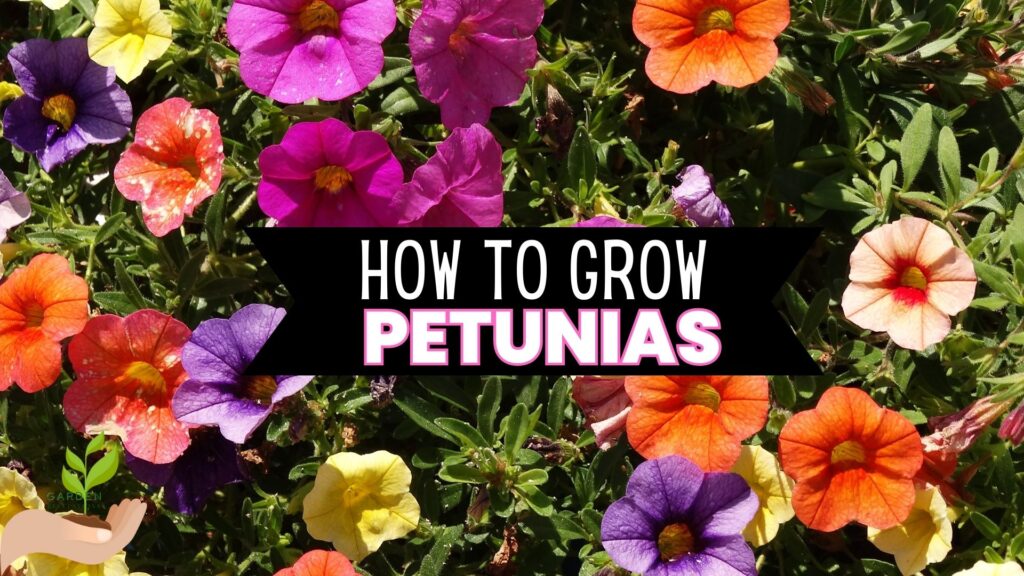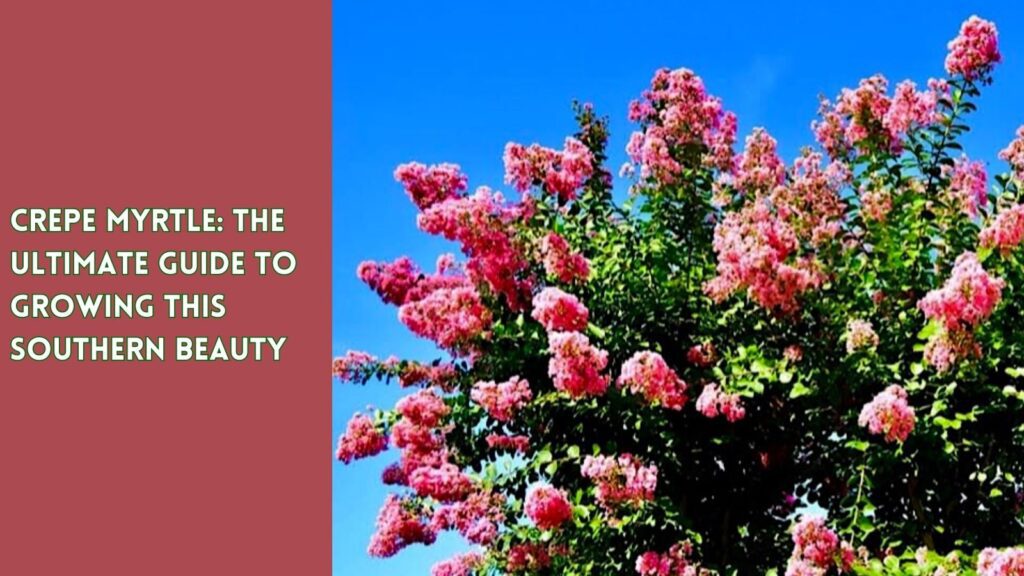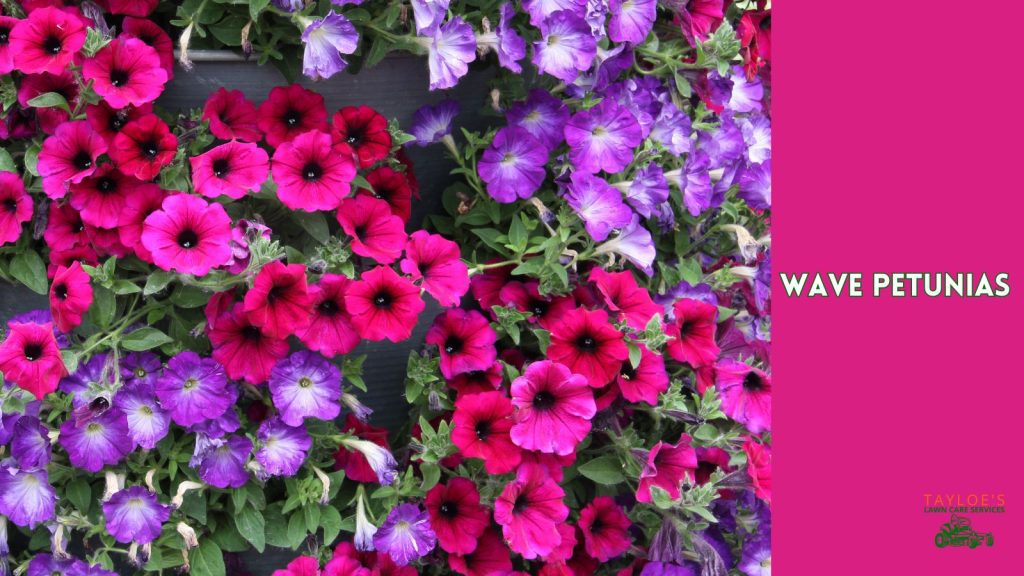Last Updated on: 12th March 2025, 09:52 am
Growing petunias is easy and oh-so-satisfying
Petunias are a garden favorite known for their abundant blooms and vibrant colors. Originating from South America, these flowers have been popular in gardens for centuries. With various types available, these beauties can be grown in gardens or containers to suit any outdoor space. This guide to growing petunias covers planting techniques and essential care tips to help you grow thriving and colorful plants with spectacular blooms.
The Latin name for petunias is Petunia × atkinsiana (also known as Petunia × hybrida), which refers to the standard hybrid garden species. They are annual plants that complete their life cycle in one growing season. They are suitable for USDA growing zones 2 through 11.

Five Key Types of Petunias
- Grandiflora Petunias. Grandiflora petunias are perfect for making a bold statement in your garden. However, they may require extra care, as their large, showy blooms are more susceptible to weather damage.
- Multiflora Petunias. These plants feature smaller flowers than Grandiflora varieties but produce more blooms. They are more tolerant of weather fluctuations and ideal for garden beds or containers.
- Milliflora Petunias. Compact and prolific bloomers, Milliflora petunias are perfect for small spaces or containers. Their petite flowers create a delicate, elegant display.
- Spreading or Wave Petunias. These vigorous, low-growing petunias are ideal for ground covers, hanging baskets, or containers. They spread quickly and produce abundant blooms throughout the season.
- Double Petunias. With their lush, double-layered flowers, Double petunias add a touch of luxury and lush color to any garden.
Considering the right type for your garden or container? Consider available space, desired visual impact, and maintenance preferences when selecting the perfect cultivar. Always check the care tag for your plants before purchasing.
Planting Petunias
Starting from seeds? Here are two things to remember.
1. Start the seeds indoors ten to twelve weeks before the last expected frost. Start the seeds in seed trays or pots filled with a high-quality seed starting mix.
2. Lightly press seeds into the soil surface. But do not cover them, as they need light to germinate. Keep the soil moist and maintain temperatures around 70-75°F (21-24°C) to ensure successful germination.
Are you buying transplants from the nursery? Here are two considerations.
1. Choose compact, well-branched plants with healthy green foliage and no signs of pests or diseases.
2. Use proper transplanting techniques. Gently remove the petunia from its container, taking care not to damage the roots. Plant it in your prepared garden bed or container at the same depth as in the original pot.
Next. Let’s look at how to plant these stunning flowers in the ground or containers.
Planting in the ground
1. Prepare your soil and amendments. These flowers prefer well-draining, fertile soil with a pH between 6.0 and 7.0. Amend the soil with compost or herbivore manure to increase fertility and drainage.
2. Plant petunias 10 to 12 inches (25-30 cm) apart to ensure proper air circulation and prevent overcrowding.
Planting in containers
1. Select a container with drainage holes to prevent waterlogging. Consider the mature size of your petunias when choosing a container size.
2. Use a high-quality, well-draining potting mix in your container to promote healthy growth. You may add perlite or vermiculite to improve drainage further.
Caring for Petunias

Now that you know how to plant them–what about routine care? Here are the things you need to know.
Watering
What’s the proper watering frequency and technique? Water the plants thoroughly and allow the soil to dry slightly between waterings. Container-grown petunias may require more frequent watering than those planted in the ground.
Avoiding common watering problems. Overwatering can lead to root rot. On the other hand, underwatering may cause wilting and reduced blooms. Monitor soil moisture and adjust your watering schedule accordingly.
Fertilizing
Use a balanced, slow-release fertilizer or a water-soluble fertilizer specifically formulated for flowering plants. Apply fertilizer according to the package instructions, typically every four to six weeks during peak growing season.
Pruning and deadheading
Regularly remove spent flowers (deadheading) to encourage continuous blooming. Pinch back leggy or overgrown stems to maintain a compact, bushy appearance. Prune the plants in late spring or early summer removes damaged or diseased stems. Lightly trim the plants in midsummer to encourage a flush of new growth and blooms.
Pest and disease management
Common pests and diseases include aphids, whiteflies, and slugs, which may attack petunias. Diseases like powdery mildew, gray mold, and root rot can also affect them.
Maintain proper plant spacing and avoid overwatering to reduce the risk of pests and diseases. Inspect plants regularly and treat any infestations or infections early. Use insecticidal soap or neem oil for pest control, and apply fungicides for disease management.

The Takeaway: Petunias Add Incredible Color to Your Landscape
Growing petunias can be rewarding, offering stunning blooms to beautify your garden or containers. By understanding the different petunia types and following proper planting techniques and care tips, you can cultivate healthy, vibrant blossoms that will become the envy of your neighborhood. With some attention and love, your flowers will provide a long-lasting, colorful display for you to enjoy throughout the growing season.
If you enjoyed this content, please follow Tayloe’s Lawn Care Services on Facebook, where we share lots more content.
Author Profile

- Deborah Tayloe is the CEO and co-founder of Tayloe's Lawn Care Services, LLC. She has a B.S.Ed and holds certificates in soil and water management and herbology from accredited programs.
Latest entries
 GardeningSeptember 27, 2025What perennials, shrubs, and trees don’t like fall pruning (and why)?
GardeningSeptember 27, 2025What perennials, shrubs, and trees don’t like fall pruning (and why)? Trees and ShrubsSeptember 14, 2025Fall Shrub Pruning Guide (September–October)
Trees and ShrubsSeptember 14, 2025Fall Shrub Pruning Guide (September–October) Trees and ShrubsApril 22, 2025Boxwood Blight: Early identification and isolation
Trees and ShrubsApril 22, 2025Boxwood Blight: Early identification and isolation Flower GardenApril 8, 2025John F. Kennedy Rose: Hybrid tea rose with elegant white blooms
Flower GardenApril 8, 2025John F. Kennedy Rose: Hybrid tea rose with elegant white blooms






